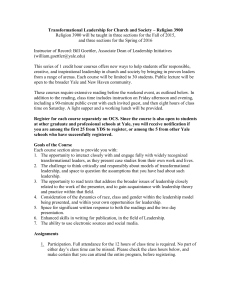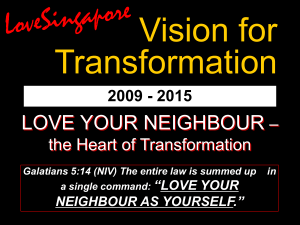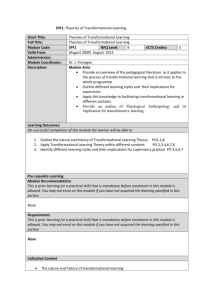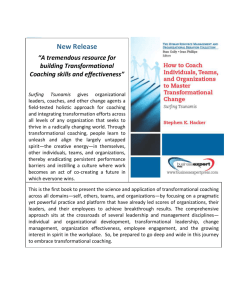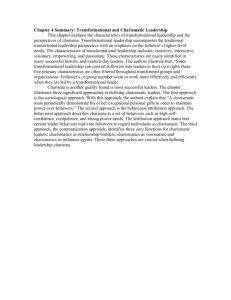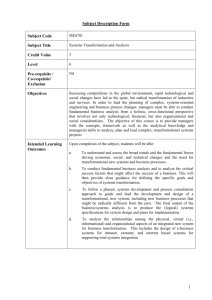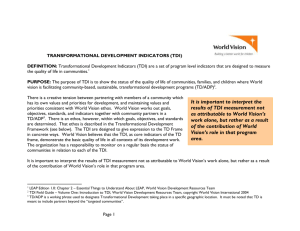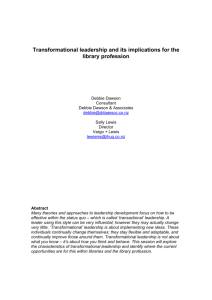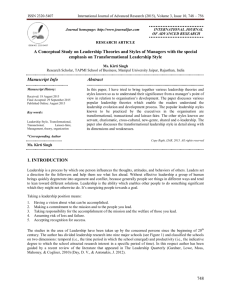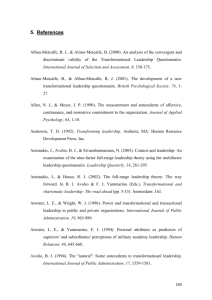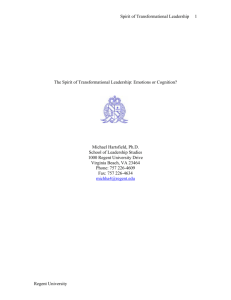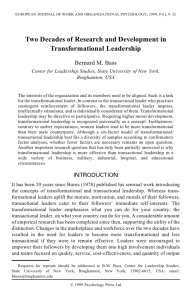Transformational Leadership in Changing Times
advertisement
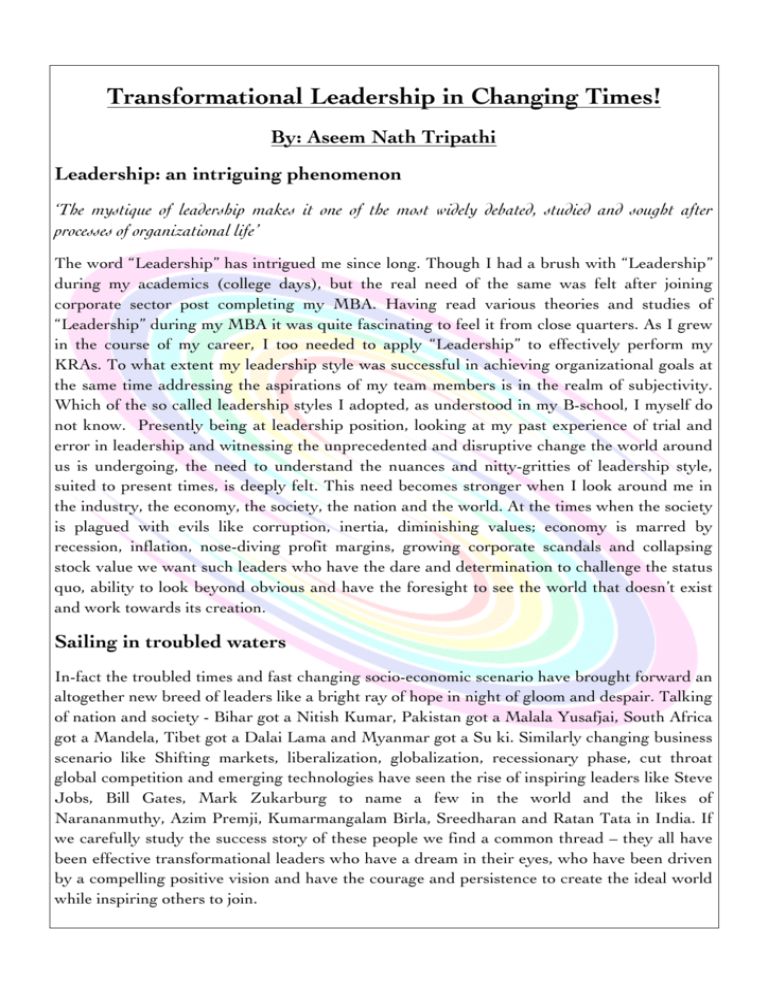
! Transformational Leadership in Changing Times! By: Aseem Nath Tripathi Leadership: an intriguing phenomenon ‘The mystique of leadership makes it one of the most widely debated, studied and sought after processes of organizational life’ The word “Leadership” has intrigued me since long. Though I had a brush with “Leadership” during my academics (college days), but the real need of the same was felt after joining corporate sector post completing my MBA. Having read various theories and studies of “Leadership” during my MBA it was quite fascinating to feel it from close quarters. As I grew in the course of my career, I too needed to apply “Leadership” to effectively perform my KRAs. To what extent my leadership style was successful in achieving organizational goals at the same time addressing the aspirations of my team members is in the realm of subjectivity. Which of the so called leadership styles I adopted, as understood in my B-school, I myself do not know. Presently being at leadership position, looking at my past experience of trial and error in leadership and witnessing the unprecedented and disruptive change the world around us is undergoing, the need to understand the nuances and nitty-gritties of leadership style, suited to present times, is deeply felt. This need becomes stronger when I look around me in the industry, the economy, the society, the nation and the world. At the times when the society is plagued with evils like corruption, inertia, diminishing values; economy is marred by recession, inflation, nose-diving profit margins, growing corporate scandals and collapsing stock value we want such leaders who have the dare and determination to challenge the status quo, ability to look beyond obvious and have the foresight to see the world that doesn’t exist and work towards its creation. Sailing in troubled waters In-fact the troubled times and fast changing socio-economic scenario have brought forward an altogether new breed of leaders like a bright ray of hope in night of gloom and despair. Talking of nation and society - Bihar got a Nitish Kumar, Pakistan got a Malala Yusafjai, South Africa got a Mandela, Tibet got a Dalai Lama and Myanmar got a Su ki. Similarly changing business scenario like Shifting markets, liberalization, globalization, recessionary phase, cut throat global competition and emerging technologies have seen the rise of inspiring leaders like Steve Jobs, Bill Gates, Mark Zukarburg to name a few in the world and the likes of Narananmuthy, Azim Premji, Kumarmangalam Birla, Sreedharan and Ratan Tata in India. If we carefully study the success story of these people we find a common thread – they all have been effective transformational leaders who have a dream in their eyes, who have been driven by a compelling positive vision and have the courage and persistence to create the ideal world while inspiring others to join. ! ! Experiential learning on “Transformational Leadership” In this mental milieu, I got an opportunity to attend a workshop on “Transformational Leadership” conducted by “Samatvam Academy” sometimes back. This experiential and transformational workshop was enlightening in the sense that it not only broadened my horizon towards the process of Transformation Leadership and competencies required for it but also provided enough intellectual and emotional stimulation to think through and work towards internalizing the concepts as I progress in my professional and personal life. Through the process of “Appreciative Enquiry” the workshop taught us that - “The transformational journey of a leader begins with an inner quest of discovering who I am and by appreciating oneself. On this conduit he must find sparks of inspiration, acknowledge the strengths and values and adopt connected perspective. Clarity of what inspires a leader is the fountainhead of great leadership”. “Transformational Leadership is yielded through a spiral of three processes, or play with three acts, being performed concurrently. Appreciating- core values and strength of oneself or department or organization; Visualizing – that is process of converting dreams into vision and a meaningful mission for present in pursuit of vision thereby developing an understanding of what people want to collectively be (Mission) and become (Vision) and Actualizing – that is working on strategy for attainment of vision with a spirit of service” The Visioning Workshop in my organization To take the learning forward in my organization I conceptualized a training session on vision, mission and values for couple of departments internally. I wanted to test the process empirically in organizational set-up, take the feedback from colleagues and see how the appreciative process yields to reflection, understanding, refinement and development of vision and mission and brings forth the insight into leadership capabilities. I then conducted a Visioning Workshop in my organization. In this workshop the focus was on understanding the importance of vision, mission and values and imbibing the process of formation of the two. I tried to impart an understanding of the concept by facilitating the group to see through and develop mission and vision of their own and of their respective departments. This workshop was done through a series of three sessions over two months (total 16 hours) and it strived to give a clarity about our (own self) values, vision and mission and seeing the convergence with that of our departments and then organization. Sessions… First Session (4 hours) focused on imparting an understanding of Vision, Mission and Values through discussion and illustrations to all group members. This was succeeded by one to one sessions of appreciative interviews (2 hours each for a group of 2) wherein I acted as a facilitator to group members and tried to enable them to reflect on their own heritage (life giving forces/core values/strengths), Vision and Mission and putting them on paper through ! ! pictorial symbols and words. In the final session (4 hours) each group member presented his mission and vision to rest of the group members. Then the two department team members worked together in paired sessions to think through and reflect on their respective department’s values, vision and mission and then put their department’s vision and mission on a chart paper. The focus was on articulation of vision and mission more clearly and delineate mission from vision. In this phase the emphasis was on the group (as against previous two phases, that focused on individual) and to understand the process of formation and vision and mission by the group. Development of Department’s vision & mission Appreciative interview session ! ! Presentation of Individual’s vision and mission ! ! ! Presentation of Department’s vision and mission ! ! ! The feedback of group members was quite positive and encouraging. As per group members the exercise was useful in a way that it not only provided them a clearer understanding of values, mission and vision of their own and of their respective departments but also enabled them discover the synergy and convergence between the two. This brought the team together, uplifted their motivation and reenergized them to work towards a common goal. The immediate outcome was that both departments were able to evolve and define their department’s mission statements that was not imposed upon them but was developed by them. Leadership Style in current scenario In prevailing business scenario, there is increasing demand for leadership that can make sense amidst ambiguity, find patterns in chaos and take charge to bring forward the change. The leadership styles vogue in 20th century (authoritarian, participative /democratic and delegative/laissez-faire) are losing its relevance in present business context. 21st Century organizations have become more open, non-bureaucratic, and flat and outwardly focused and require application of a unique leadership style. This type of leadership style should be see differently from “Transactional Leadership”, much of what a leader applies in the course work related routine transactions with the aim to increase productivity, optimize performance using least resources, keeping an eye on bottom line and keeping customers and stakeholders satisfied and happy. Unfortunately most of ‘manager-leaders’, due to enormity of work, obstacles in the way, expectation of bosses and pressure to perform tend to follow the “tested path” as followed by their predecessors thus perpetuating the status quo. I have been no exception. Most of us want to do things that are meaningful and different and inspire others to leave a legacy behind but we are so absorbed in our mundane life that such thoughts may come to our minds in flashes but seldom transform into action. Manager versus Leader In preceding paragraph I have used the word ‘manager-leader’ as most of so called professional leaders (whatever their rank be and howsoever senior they are!) remain more of a manager than a true leader. What is it that differentiates a leader from manager? The prime role of a “Manager” is to strive towards achievement of optimum output from minimum input. He does so by resolving various conflicts of values, situations, circumstances and aspirations into synergy and engages with people. Whereas a Leader’s main role is to catalyze “transformation”. Leaders have clear vision for future and mission for present. With a dream in their eyes, they are always in pursuit of converting their vision into action. “Leaders keep their eyes on the horizon, not just on the bottom line” So the leaders without a dream and vision are more of “Managers”. Transformational Leaders have vision in back of their minds, are value driven change agents and exhibit the capacity to deal with ambiguity and uncertainty, while believing in people. They have firm faith in their values and are inspired by strong urge to change the world around them for better future. ! ! They have the ability to align others to attain their vision. A Transformational leader translates organizational vision and objectives into challenging and meaningful goals for others “Leadership is the capacity to translate vision into reality” – Warren Bennis Power of vision and Leadership Thus compelling positive vision for future, action towards a mission for present in pursuit of vision and firm belief in values to sail through testing times are building blocks of paradigm of “Transformational Leadership”. Joel Barker beautifully sums up in his movie “Power of Vision” …’Vision without action is merely a dream; action without vision is simply passing the time but vision with action is making a positive difference that can change the world’. According to Jonathan Swift “Vision is art of seeing what is invisible to others”. Stephen wise aptly says “Vision looks inward becomes a duty and vision looks outward and become aspiration”. We are limited not by abilities but by vision! ! ! """""""""""""""""""""""""""""! References 1. 2. 3. 4. Human Capital, Vol. 16 No.1 June 2012 ‘Transformational Leadership’ study material by Samatvam Academy ‘Power of Vision’ by Joel Barker Wikipedia ! Aseem Nath Tripathi Head – HR Ahluwalia Contracts (India) Limited Email – aseem_nt@hotmail.com Mobile - +91-9818470994 !




